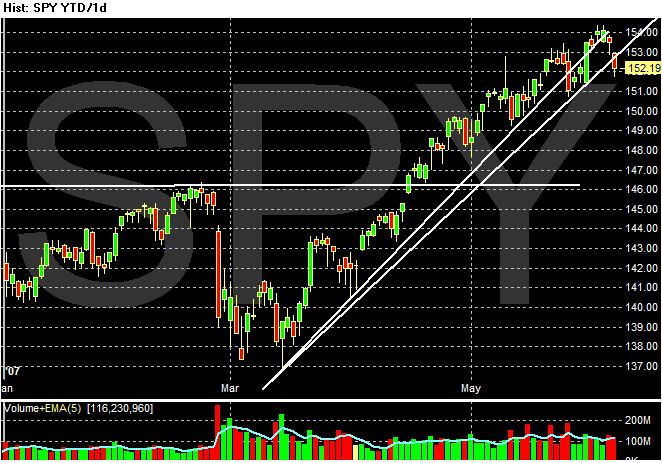
Using the trend line futhest to the left, we have the trend rising just over the line followed by two days of higher volume selling. Using the trend line to the right, we still have a clean move through the trend with higher volume selling. Either way, tt looks as though the SPYs may be moving into a period of consolidation of their recent gains.
However, this is not a complete disaster. Using a P&F chart, we see the market is still in am upswing -- although this chart too is also close to adding a downward column.

The primary reason for today's loss was an increase in labor costs and the possibility of higher inflation:
Labor costs rose three times faster than the government's previous estimate last quarter, increasing the odds companies will push up prices. Federal Reserve Bank of Cleveland President Sandra Pianalto today also joined Fed Chairman Ben S. Bernanke in warning that prices are rising too quickly. European stocks posted their biggest decline in more than two months on concern policy makers will keep raising interest rates to rein in inflation.
``Inflation causes reduced consumer spending, it squeezes profit margins,'' said John Kornitzer, who manages $6 billion at Kornitzer Capital Management in Shawnee Mission, Kansas. ``The market has been making new highs. It can't go up forever.''
The S&P 500 lost 13.57, or 0.9 percent, to 1517.38. The Dow average fell 129.79, or 0.95 percent, to 13,465.67. The Nasdaq Composite Index retreated 24.05, or 0.9 percent, to 2587.18.
Stocks yesterday posted their first decline in a week after bond yields surged and Bernanke said core inflation ``remains somewhat elevated.''
While higher productivity can absorb higher labor costs, productivity also showed signs of decreasing.
It's also important to note this latest rally started in early March -- nearly three months ago. Some selling might be warranted here simply as as traders lock in some profits.